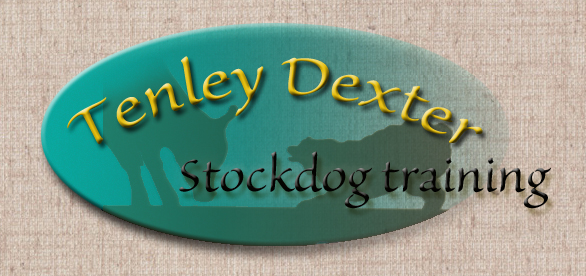
Starting Your Puppy
Training Begins As Soon As Possible
The following videos will show how I introduce my 15 week old pup to some commands that I will eventually use in their stock work during a fun session of tug and fetch game. It is a perfect bonding as well as self control and hierarchy exercise. My voice is always encouraging and positive. Short frequent sessions are better than occasional long ones. It's hard to keep the pup’s interest and enthusiasm for more than 10 minutes or so. Get what you are looking for and quit. Don’t expect your pup to be perfect but instead build towards that goal and accept small steps toward the behavior you are trying to teach. Training is cumulative over time.
By teaching a down, stand, there, walk up, an out, leave it and letting pup tug gives a great leg up to stock work commands when I take my puppy to stock. Each pup will enjoy a different type of toy to tug with and motivation is key. At the end of the session, the toy is put away where the pup can’t reach it. The human owns the toy which increases the human's stature in the canine hierarchical structure and the game builds a teamwork approach in the relationship.
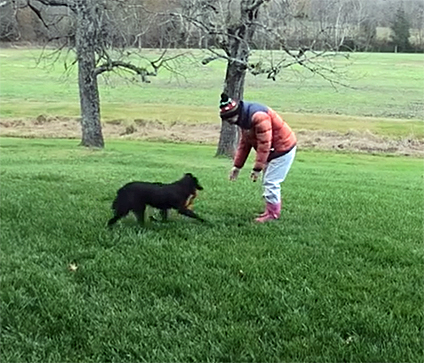
Click here for video 1
Click here for video 2

Introduction to Pressure
It's never too soon to start simple obedience and pressure exercises on your pup as long as they are done in an encouraging fashion. The small plastic shrub rake (bought at any gardening department) is lightweight but visual enough for the pup to see at their eye level. The rake is made of plastic, so, if and when I need to tap or apply pressure to the pup, it's more of a shock factor than anything else. I use it to block, pressure and even to please and reward her by rubbing the pup’s belly with it. It's an extension of me at her level so I don't need to bend down and she doesn't need to look up at me.
I apply the least amount of pressure necessary to get the result I'm looking for. If a small amount of pressure doesn't get the resultyou are looking for, a change in behavior, increase it till you do get the desired response. No two pups/dogs are created the same and we must be able to observe the different responses to pressure and adjust our pressure accordingly. The two pups in the videos have very different responses to pressure.
The following are two very different pups. One pup is very reactive to the rake and the other not so much at least at first. No two pups are created the same but we are looking for the same reaction to the pressure in the end.
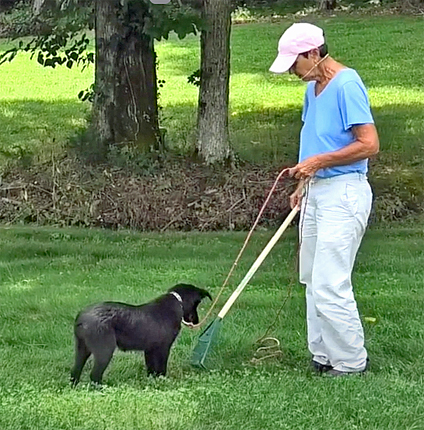
Click here for video
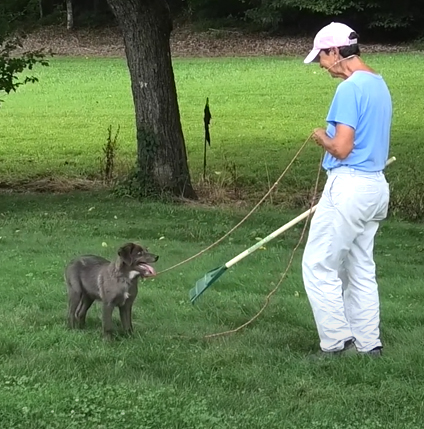
Click here for video

Setting Up Your Working Area, The Classroom
The following videos with explanations demonstrate my method of starting young dogs. It is a progressive, step oriented approach that anyone can do. I start pups on slower moving ducks. A few x-pens and a corner will do if you don’t have a small working area. |
|
- A small area is used so the handler can easily be in control of the dog when necessary. Many refer to this as a ‘control pen’. Make sure that the handler can reach any part of the pen within a few steps to influence the dog.
- The handler must establish that they are the pack leader of the activity. The dog works stock for the handler, especially for very ambitious and high drive pups. The small area lends itself to attain this goal.
- Slow moving ducks that want to stay together keep the learning environment/classroom as stress free as possible. I use Call duck drakes which are usually quieter than the hens. Quiet, very dog broke sheep that are very people oriented can also be used in slightly bigger area but of course more solid fencing is required. Again, make sure the handler can reach all areas of the pen within a few steps. Never use stock that is extremely flighty. Stock that can outrun a pup will cause panic in a pup which is often exhibited by riding the side of stock or grabbing onto stock in attempts to control it. We want to create a classroom where the pup will be interested and successful in controlling livestock but in calm and confident manner, not chasing or bullying the stock.
|
|
| |
 |
There are 3 ways to train/communicate with a dog:
|
|
| |
- Show or Lure.
- Use a short line to show the dog what you are teaching him.
Stock is used as a lure.
- Pressure
- Dogs learn from the release of the pressure, not its application. I use a cheap plastic shrub rake initially as it is more visual for the dog than a stock stick. The rake allows pressure to be applied down at the dog’s eye level. In case a dog needs a physical correction, plastic is more effective for delivering shock factor than actually inflicting pain. There are some pups that are so sensitive in the initial phases of stock training, that no tool is necessary but perhaps becomes needed as the pup becomes more bold and comfortable.
- For the tool’s pressure to get the desired results, the tool must be in the correct spot on the dog’s body to get the desired response. Tool in front of the dog, dog slows, stops or reverses. Tool at the point of the shoulder, the dog gets wider. Tool behind the dog, the dog gets faster and usually tighter. For any of you that have taught a horse to lunge or those that have lunged a horse, this should make perfect sense to you. A horse has 4 legs and so does a dog. The only difference is there isn’t a bucket of grain (stock for the dog) in the middle of the lunge circle and the dog is a much smaller target to pressure so it requires some degree of practice and skill to do it correctly.
- Correction
-
Correction should always be appropriate to the situation and the temperament of the individual dog. Some dogs simply need to see the tool brought in front of the eye to get the desired response and some dogs are a little thicker skinned or so fixated and “in the zone” when on stock and may require a harder correction to get their attention. Anger should never enter the correction phase. Love the dog but take exception to undesirable actions it makes. Dogs become what they practice so if undesirable behaviors are allowed to be practiced for too long, that is what the dog is learning. Repeated correcting at too low a level only serves to desensitize a dog to correction. Watch the pup’s reaction to correction and adjust up or down accordingly.
-
I don’t yell or raise my voice at the pup. Let showing, luring, pressure and correction do the training and keep your voice soft, positive and encouraging while quietly naming with commands what the pup is doing. Your goal should be to develop a partnership with your dog, not an adversarial relationship.
|
|
| |
All three of these methods will be used while starting the pup. Sometimes only one method will be implemented and sometimes two methods will be used simultaneously |
| |
 |
ABCs/3R’s vs. Gym Class |
There are really only two things dogs do while working stock, either fetching or driving. Gym Class is what I call having the dog fetch and balance stock to the handler. For a natural fetching dog, minimal commands are necessary as it is instinctual to bring stock.
The dog gets to make more choices and express their natural instincts of grouping and gathering stock. A pup is pre-programmed by nature to understand pack hierarchy and while it doesn’t include a human, it’s the handler’s job to instill themselves as the leader of the herding ritual. In fetching the handler becomes the dog’s point of reference as to where stock should be brought , the destination of the fetch, as the handler walks about the area aka a Walk About.
|
|
| |
- Gym Class
- I use a general command…get around, bring em, round em up, etc. rather than directional (go bye/come bye, away to me which I use for driving) commands. The dog should be able to bring stock on balance to a handler without commands. You will notice in the video that I walk roundly backwards rather than straight back. Round handler movement produces round dog motions. Straight handler movement produces straight movement of the dog. The straighter I would walk, the more forward, straight and pushy the pup would become. Most pups are very keen and pushy initially so walking straight backwards encourages the pup to push the stock past the handler and defeats the goal of showing the pup the correct location of the balance, the handler’s core. By keeping my movement round, the pup keeps trying to find balance by moving laterally rather than forward, thus not exerting less pressure on the back of the stock. Pups expend their energy going laterally rather than forward.
- With time, as the pup settles into a nice pace in balance, I would give the reward of more straight backwards steps to let him fetch forward rather than going laterally rebalancing. My goal is for the pup to find balance to my core, keeping stock together, downshifting/rating and becoming comfortable as I walk around the pen.
- Rake work…your rake should always be opposite the heads of stock which means you will change hands often and quickly as the ducks or sheep look away from the handler. The rake blocks the pup and tells him that the “door is closed”, and they should return back to the heads of the stock. Dogs steer stock on the head/eye and dogs push stock on the rear. When we need a dog to steer the stock to balance with the handler, the dog need only go as far laterally on the eye/head as to get the stock to look at the handler.
- In the following videos you will see me change my rake hand every time the stock changes the direction. When the pup is flanking around the stock, the tip of the rake belongs on the dog’s point of shoulder to keep the round motion of the pup and prevent them spiraling tighter as they go around the stock. Your rake and your feet are your biggest assets training a pup.
|
|
| |

|
| |
Balancing ABCs and Gym Class during a session with a youngster will depend on the demeanor of the pup. Hesitant or less engaged pups need more Gym Class to build interest. Movement of stock produces interest. Pushy ambitious pups need more ABCs and sometimes very little Gym Class in the beginning. As the pups settle into the process, the percentage of ABCs to Gym Class will change and vary session to session.
I hope this video shows an easy stress free way to start your young stockdog. One should endeavor to produce a confident working dog with a ton of self control.
Roxy's first exposure to working the ducks.
- Goals:
- pup responding to the block of the rake by changing directions
- keeping pup on the outside of the stock to keep it together
- downs/stops when stock is settled
- ABCs for intro to driving
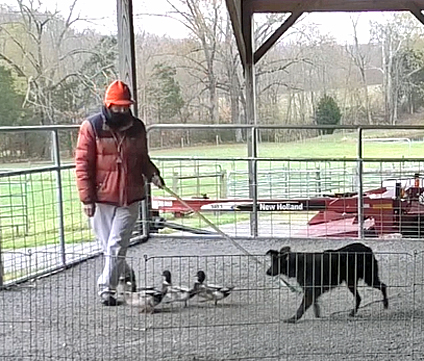
Click here for video
Second session with Roxy:
- Goals
- pup responding faster to block of the rake
- keeping pup on the outside of stock
- pressuring the pup to reposition around stock without always pressuring the stock, understanding of round versus straight
- cutting down the over flanking (circling) of the pup in the goal of the pup finding balance to the handler
- teaching pup to get stock off the fences by careful slow pieces of positioning rather than forcing a hole which never works.
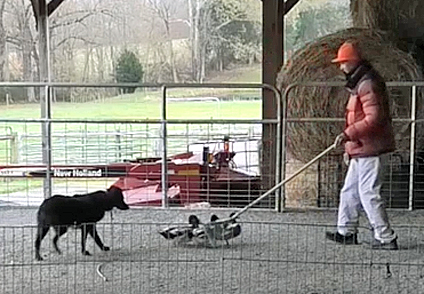
click here for video
Practicing ABC’s With Feeding Chores
The next video shows Roxy practicing ABC’s doing the feeding chores with some of my replacement ewe lambs. There are always multiple ways to practice the same principles so a dog doesn’t get bored. Despite her young age, I can get the job done and encourage calmness and self control.
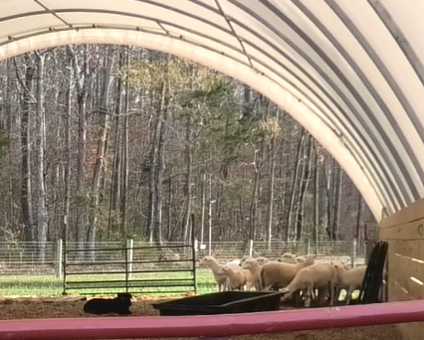
click here for video
Stay tuned and revisit to see the next stages in Roxy’s training including but not limited to, mini baby outruns, teaching the “watch ‘em/hold ‘em” command and teaching pace.
These step by step instructions are tried and true both with my own dogs and assorted breeds of dogs of my students. Don’t skip steps and don’t be afraid to go back to review if you are having troubles. For those who may not have regular instructional help with your dog and you feel you need more help than the video, check out my clinic schedule on my website, http://www.tenleydexter.com. I am also available for Zoom lessons by appointment. Contact me by e-mail at Ten11ey@yahoo.com.
|
| |
|
|


![]()

![]()


![]()




